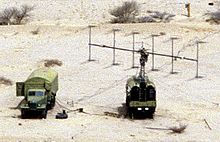P-12 radar

P-12 "Spoon Rest A" operating in Somalia
|
|
| Country of origin |
|
|---|---|
| Introduced | 1956 |
| Type | Early Warning Ground Control |
| Frequency | VHF |
| Range | 200 km |
| Altitude | 25 km |
| Azimuth | 360 degrees |
| Precision | 1 km range |
| Power | 180 kW |
The P-12 "Yenisei" (also referred to by the NATO reporting name "Spoon Rest" in the west) was an early VHF 3D radar developed and operated by the former Soviet Union.
The P-12 Yenisei was a development of the earlier P-10 radar, the P-12 being developed between 1954 and 1956. The P-12 was developed by the SKB Design Bureau, a division of State Plant No.197 named after V. I. Lenin who developed the previous P-10, the predecessor of the current Nizhny Novgorod Research Institute of Radio Engineering (NNIIRT). The Yenisei radar was accepted into service in 1956 following the successful completion of the radars test program.
In 1958 a modernised variant of the P-12 passed the testing process and entered into service as the P-12M, the modernised radar featured the ability to shift the radar frequency within a range of 10 MHz. A further modernisation came in 1962 in the form of the P-12MP which featured improved reliability, reduced side lobe radiation and the ability to be paired with a centimeter band search radar, in 1970 the radar was provided with flicker equipment to improve immunity to anti-radiation missiles. The final variant of the P-12 was the P-12NP which was also produced as the P-12NA with a different transport chassis. The P-12NP compared with the previous P-12MP featured improved detection ranges and reliability as well as the ability to locate the control cabin up to 500 meters from the antenna to improve crew survivability as a result of attack on the radar.
The main differences between the earlier P-10 and the P-12 included a new antenna feed system with lower side lobes, reduced to 4% of the main lobe. The P-12 also offered a greater frequency range and greater frequency agility, being able to retune to four pre-set frequencies automatically as well as automatic frequency fine tuning. Finally Yenisei had greater accuracy with improved detection range (250 km) and better protection against passive and active interference. In addition to frequency agility the P-12 was the first Russian radar system to use the coherent cancellation moving target indicator (MTI) method to eliminate ground clutter.
...
Wikipedia
